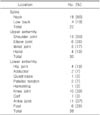| Korean J Sports Med. 2015 Dec;33(2):83-87. Korean. Published online December 07, 2015. https://doi.org/10.5763/kjsm.2015.33.2.83 | |
| Copyright © 2015 The Korean Society of Sports Medicine | |
|
Joon Yub Kim,1
Seung Jun Moon, | |
|
1Department of Orthopedic Surgery, Myongji Hospital, Seonam University School of Medicine, Goyang, Korea. | |
|
2Department of Orthopedic Surgery, Bundang Jesaeng Hospital, Seongnam, Korea. | |
| Received September 09, 2015; Revised October 02, 2015; Accepted October 20, 2015. | |
|
This is an Open Access article distributed under the terms of the Creative Commons Attribution Non-Commercial License (http://creativecommons.org/licenses/by- | |
|
Abstract
| |
|
The aim of this survey was to analyze the characteristics of musculoskeletal pain of Korean junior tennis players and its effect on games and psychology of players. Surveys were administered to 30 healthy male junior tennis players who took part in a 50th national junior tennis meet in 2015. We analyzed the incidence, location, cause and preferred prevention or treatment method of musculoskeletal pain, the correlation between training time and musculoskeletal pain as well as the effect of musculoskeletal pain on games and psychology of players. Overall, 22 out of 30 (73.3%) responded the experience of musculoskeletal pain. The incidence of lower extremity pain (16 out of 30, 53.3%) were higher than upper extremity pain (9 out of 30, 30%) and low back pain (8 out of 30, 26.7%). The long training hours per day (r=0.574, p=0.001) and old age (r=0.390, p=0.033) were correlated with intermittent back pain in univariate anlaysis. In multivariate ananlysis, the long training hours per day was a single risk factor of intermittent low back pain (p=0.038, odds ratio 10.01). 43.3% of players responded that the insufficent preventive conditioning program was thought to be the cause of musculoskeletal pain. The most preferred treatment or prevention method for musculoskeletal pain was rehabilitation (55.3%). Twelve players reported the negative affection of musculoskeletal pain to the performance in game. Six players experienced the frustration, 9 players experienced the loss of interest and 9 players experienced the emotional avoidance of games due to the musculoskeletal pain. |
|
Keywords: Tennis; Youth; Adolescent; Musculoskeletal pain; Sports injury; Survey study |
|
|
Supplementary Material
|
Supplement Fig. S1. Supplemental data can be found at: http://dx.doi.org/10.5763/kjsm.2015.33.2.83
Questionnaire (survey for musculoskeletal pain of junior tennis players).
Click here to view.(130K, pdf)|
Tables
|
|
|
|
|
|
Notes
|
Conflict of Interest:No potential conflict of interest relevant to this article was reported.
|
Acknowlegements
|
The authors thank Doo Soo Song, tennis coach of Goyang Middle School for and Dr. Jung Soo Choe, for survey data collections.
|
References
|
| 1. | Pluim BM, Loeffen FG, Clarsen B, Bahr R, Verhagen EA. A one-season prospective study of injuries and illness in elite junior tennis. Scand J Med Sci Sports. 2015 May 05; [doi: 10.1111/sms.12471] [Epub].
|
| 2. | International Tennis Federation. Ranking search [Internet]. London: The International Tennis Federation; 2015 [cited 2014 Jun 1]. Available from: http://www.itftennis.com/juniors/rankings/player-
|
| 3. | DiFiori JP, Benjamin HJ, Brenner J, et al. Overuse injuries and burnout in youth sports: a position statement from the American Medical Society for Sports Medicine. Clin J Sport Med 2014;24:3–20. |
| 4. | Bylak J, Hutchinson MR. Common sports injuries in young tennis players. Sports Med 1998;26:119–132. |
| 5. | Kibler WB, Safran MR. Musculoskeletal injuries in the young tennis player. Clin Sports Med 2000;19:781–792. |
| 6. | Kibler WB, McQueen C, Uhl T. Fitness evaluations and fitness findings in competitive junior tennis players. Clin Sports Med 1988;7:403–416. |
| 7. | Chandler TJ, Kibler WB, Uhl TL, Wooten B, Kiser A, Stone E. Flexibility comparisons of junior elite tennis players to other athletes. Am J Sports Med 1990;18:134–136. |
| 8. | Hutchinson MR, Laprade RF, Burnett QM 2nd, Moss R, Terpstra J. Injury surveillance at the USTA Boys' Tennis Championships: a 6-yr study. Med Sci Sports Exerc 1995;27:826–830. |
| 9. | Bahr R. No injuries, but plenty of pain? On the methodology for recording overuse symptoms in sports. Br J Sports Med 2009;43:966–972. |
| 10. | Gregg JR, Torg E. Upper extremity injuries in adolescent tennis players. Clin Sports Med 1988;7:371–385. |
| 11. | Kibler WB, Chandler TJ, Uhl T, Maddux RE. A musculoskeletal approach to the preparticipation physical examination: preventing injury and improving performance. Am J Sports Med 1989;17:525–531. |
| 12. | Warner JJ, Micheli LJ, Arslanian LE, Kennedy J, Kennedy R. Patterns of flexibility, laxity, and strength in normal shoulders and shoulders with instability and impingement. Am J Sports Med 1990;18:366–375. |
| 13. | Chandler TJ, Kibler WB, Stracener EC, Ziegler AK, Pace B. Shoulder strength, power, and endurance in college tennis players. Am J Sports Med 1992;20:455–458. |
| 14. | Kibler WB, Chandler TJ, Stracener ES. Musculoskeletal adaptations and injuries due to overtraining. Exerc Sport Sci Rev 1992;20:99–126. |




 ePub
ePub Citation
Citation Print
Print





